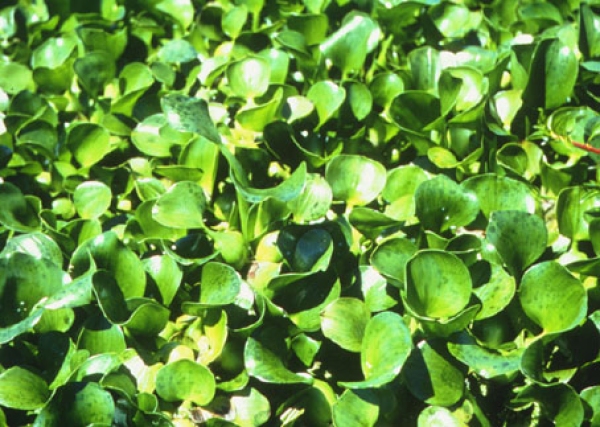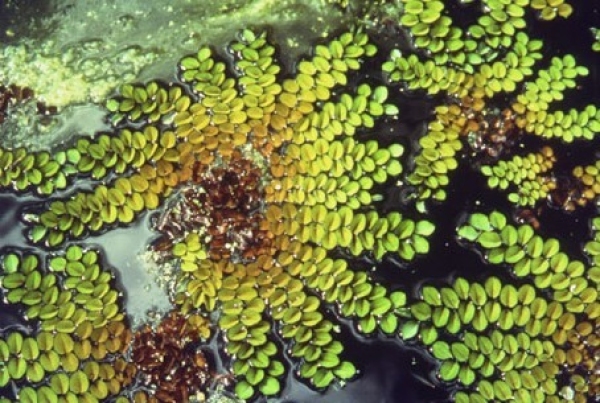Family: Azollaceae
Azolla filiculoides Lam.
Azolla filiculoides is a small free-floating fern that forms a conspicuous, bright red surface cover on fertile, ponds, lakes and drains. The plants are 1–2.5 cm long, ovate in outline and have branches comprised of numerous small, alternate and overlapping leaves that may conceal the branching horizontal stem. The leaves may be red or green, but are typically red in full sunlight. The roots are filiform, without branches and grow to 5 cm in length. Propagation is both vegetative and sexual.
Azolla filiculoides is widespread throughout New Zealand and is easily confused with A. pinnata, an introduced species of Azolla that is common throughout the upper North Island. These two species are distinguished by the more open structure of A. pinnata and by its branched feathery roots that form numerous root-hairs.
Family: Lemnaceae
Lemna minor L. (commonly called duckweed)
Duckweed is a small free-floating plant that can cover the surface of wind-protected fertile waters. It is a native species and widespread throughout New Zealand.
L. minor is characterised by its 2 to 4 small platelet leaves (3–4 mm in length) that have a single root each, terminating in a conspicuous root cap. This feature also distinguishes L. minor from Spirodela punctata and introduced duckweed that has two or more roots per platelet.
Family: Pontederiaceae
Eichhornia crassipes (commonly called water hyacinth)
Water hyacinth is a large free-floating stoloniferous perennial that forms thick dense mats of vegetation across the surface of lakes, ponds and waterways. It has bright green glossy leaves, inflated bladder like petioles and thick fleshy stolons that radiate in all directions from a vertical stem. The flowers too are distinctive, bluish-purple in colour and ca. 6cm across on a terminal spike.
Water hyacinth is acknowledged worldwide as a troublesome aquatic weed. It was introduced into New Zealand as an ornamental plant, and spread to a number of sites in the North Island from which it has now been mostly eradicated. It is an illegal plant that is occasionally still found in private ponds.
Family: Salviniaceae
Salvinia molesta Mitchell (commonly called salvinia)
Salvinia is a free-floating fern. The young plants have well spaced, small (1.5 cm long) pale green leaves that lie flat on the surface of the water. Mature leaves are brownish and more crowded, compacted and folded, forming dense mats. Plants are usually up to 30 cm long. Leaves occur in whorls of three with only the upper two forming true leaves above the water surface, whilst the lower leaf which resembles a root hangs down into the water. The upper leaf surface is water repellent and covered in distinct white hairs.
The plants are frost-sensitive, growing best at temperatures over 20°C, however they can survive in protected waters or frequently inundated damp mud. They are found in the North Island, north of the Waikato.
Salvinia can be a serious weed in tropical countries, capable of rapid growth. In New Zealand it is an illegal plant that is occasionally still found in private ponds.
For further information on these plants species see:
B.T. Coffey and J.S. Clayton. (1988). New Zealand Waterplants: A guide to plants found in New Zealand. Ruakura Agriculture Centre, Hamilton.


